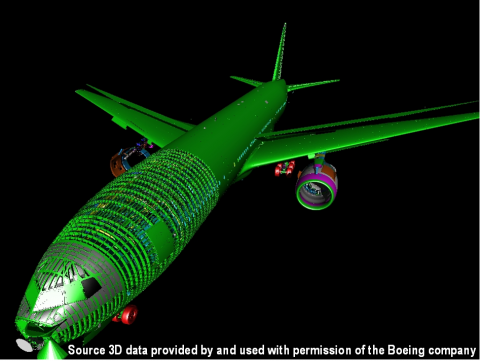Visibility culling is a fundamental problem of computer graphics, and is of crucial importance for many applications, like game development or architectural design. For example, interactively rendering a model containing hundreds of millions of polygons like the Boeing 777 model shown on the cover page is only possible when invisible parts of the model are "culled" away. Solving the visibility problem has been an important research topic for many years, and countless methods have been proposed. Amazingly, most approaches still have more or less serious issues that prevent their widespread use. Preprocessed visibility solutions attempt to solve the problem in an offline step, but are often slow, lack robustness, and are hard to implement. Online culling algorithms have a lot of potential since they can be used on arbitrary scenes, but they induce an overhead during rendering which is unacceptable for applications that strive for optimal performance. We believe that basic research problems remain unsolved until this day for preprocessed visibility as well as for online culling, and the goal of this project is to tackle and solve the majority of these problems. In order to do this, we have to gain more insight into the complex properties of visibility, which are still not entirely understood. Our proposed methods have applications in various fields, like game development, architectural design, urban visualization, or massive model visualization.
Funding
- FWF P21130-N13
Research Areas
- In this area, we concentrate on algorithms that synthesize images to depict 3D models or scenes, often by simulating or approximating the physics of light.
Publications
| Image | Bib Reference | Publication Type |
|---|---|---|
| 2013 | ||
 |
Veronica Sundstedt, Matthias Bernhard, Efstathios Stavrakis, Erik Reinhard, Michael Wimmer Visual Attention and Gaze Behaviour in Games: An Object-Based Approach In Game Analytics: Maximizing the Value of Player Data , pages 543-583, April 2013 |
Article in a Book |
| 2011 | ||
 |
Matthias Bernhard, Karl Grosse, Michael Wimmer Bi-modal Task Faciliation in a Virtual Traffic Scenario through Spatialized Sound Rendering ACM Transactions on Applied Perception, 8(4):1-22, November 2011. |
Journal Paper (without talk) |
Matthias Bernhard, Le Zhang, Michael Wimmer Manipulating Attention in Computer Games In Proceedings of the IEEE IVMSP Workshop on Perception and Visual Signal Analysis, pages 153-158. June 2011. [  paper] paper] |
Conference Paper | |
 |
Le Zhang Improving the Visibility of In-Game Advertisements [  poster] [ poster] [ thesis] thesis] |
Master Thesis |
 |
Jirí Bittner , Oliver Mattausch, Ari Silvennoinen, Michael Wimmer , Oliver Mattausch, Ari Silvennoinen, Michael Wimmer Shadow Caster Culling for Efficient Shadow Mapping In Proceedings of the ACM SIGGRAPH Symposium on Interactive 3D Graphics and Games 2011, pages 81-88. February 2011. [  draft] draft] |
Conference Paper |
 |
Oliver Mattausch, Daniel Scherzer, Michael Wimmer Temporal Screen-Space Ambient Occlusion In GPU Pro 2, pages 123-142, February 2011 |
Article in a Book |
 |
Michael Präauer, Herbert Moldan Preparing an Eyetracking Experiment with a Computer Game |
Student Project |
 |
Daniel Scherzer, Lei Yang, Oliver Mattausch, Diego Nehab, Pedro V. Sander, Michael Wimmer , Elmar Eisemann , Elmar EisemannA Survey on Temporal Coherence Methods in Real-Time Rendering In EUROGRAPHICS 2011 State of the Art Reports, pages 101-126. 2011. [  pdf] pdf] |
Other Reviewed Publication |
 |
Markus Radits A gaze adaptive HDR image viewer |
Student Project |
| 2010 | ||
 |
Oliver Mattausch, Daniel Scherzer, Michael Wimmer High-Quality Screen-Space Ambient Occlusion using Temporal Coherence Computer Graphics Forum, 29(8):2492-2503, December 2010. |
Journal Paper (without talk) |
 |
Matthias Bernhard, Efstathios Stavrakis, Michael Wimmer An Empirical Pipeline to Derive Gaze Prediction Heuristics for 3D Action Games ACM Transactions on Applied Perception, 8(1):4:1-4:30, October 2010. |
Journal Paper (without talk) |
 |
Oliver Mattausch Visibility Computations for Real-Time Rendering in General 3D Environments Supervisor: Michael Wimmer  Duration: January 2005 — April 2010 [  phd] phd] |
PhD-Thesis |
 |
Stefan Reinalter Visibility in a real-world cross-platform game engine [  poster] [ poster] [ Thesis] Thesis] |
Master Thesis |
 |
Alex Druml, Markus Ernst, Lukas Rössler Out-of-Core rendering and simplifications for rendering large scenes |
Student Project |
 |
Albert Julian Mayer Megatexture [  doc] doc] |
Student Project |
 |
Markus Ernst, Alex Druml, Lukas Rössler Implementing out-of-core algorithms |
Student Project |
 |
Oliver Mattausch Visibility Algorithms for Real-Time Rendering. Suedwestdeutscher Verlag fuer Hochschulschriften, 2010. |
Published Book |
 |
Simon Wallner Comparing SSAO methods in Ogre [  doc] doc] |
Student Project |
| 2009 | ||
 |
Daniel Scherzer, Michael Schwärzler, Oliver Mattausch, Michael Wimmer Real-Time Soft Shadows Using Temporal Coherence In Advances in Visual Computing: 5th International Symposium on Visual Computing (ISVC 2009), pages 13-24. December 2009. [  Preprint] Preprint] |
Conference Paper |
 |
Jirí Bittner , Oliver Mattausch, Peter Wonka , Oliver Mattausch, Peter Wonka , Vlastimil Havran, Michael Wimmer , Vlastimil Havran, Michael Wimmer Adaptive Global Visibility Sampling ACM Transactions on Graphics, 28(3):94:1-94:10, August 2009. [  Preprint] Preprint] |
Journal Paper with Conference Talk |
 |
Jirí Bittner , Oliver Mattausch, Michael Wimmer , Oliver Mattausch, Michael Wimmer Game-Engine-Friendly Occlusion Culling In SHADERX7: Advanced Rendering Techniques, pages 637-653, March 2009 |
Article in a Book |
 |
Wolfgang Knecht Textture-atlases for large scenes |
Student Project |
| Michael Beham, Manuel Hochmayr Enhancing Vienna Scene |
Student Project | |
Michael Wimmer Visibility Computation in Computer Graphics, 2. February 2009- 4. February 2009, Eibiswald, Austria |
Invited Talk | |

